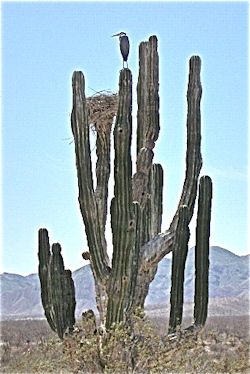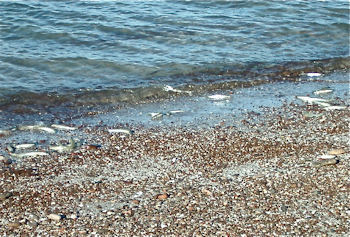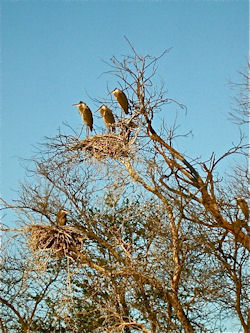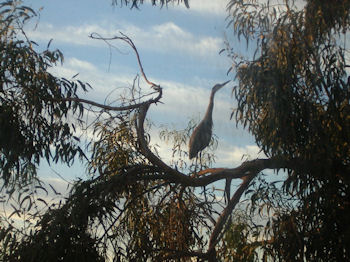 |  |
By Georgia Tanner

In the spring of 2012, while camped near a grove of tall trees, I was able to watch the entire nesting cycle of four heron families south of San Felipe. The cycle began with egg-laying in March and ended with fledglings flying from the nests in June. My favorite image is of almost-mature fledglings waiting for mom to come back with the fish.
The Great Blue Heron is common to both coasts of Baja California, and you too may be entertained by these 4 ft. tall, long-necked laser-eyed hunters--as I was one afternoon on the Gulf of California. Returning from a swim, I noticed broken lines of silver at the water’s edge, like strips of tinfoil flashing in the sun. It was a grunion run, the elusive Gulf grunion that run in daytime as well as night and are able to coordinate their beach spawning with the northern Gulf’s extreme tides.
I sat on the beach and watched nature turn on. The seagulls flopped and tripped over each other as they struggled to catch the slippery little fish; five-to-six-inch-long gyrating grunion were just too much for their beaks. They galloped and grabbed, but during an hour of watching I never saw a gull score a fish. The Great Blue, however, designed for live prey at the water’s edge, was in heron heaven. She stalked, stabbed, and dined again and again, with precision and dignity.
The tide finally receded and the grunion disappeared, leaving several frustrated seagulls, one enchanted human, and one stuffed Great Blue Heron, who barely cleared the bushes on her flight home to the nest.

Herons don’t always eat fish, as I learned one morning while concealed in the folds of a hammock. That morning a Great Blue did his pause-and-step walk to the dunes a few yards north of the hammock. There he remained, staring at something in the dune grass, motionless except for neck feathers flowing backward in the breeze. Suddenly his beak darted earthward and speared a lizard. After a gulp and a swallow and a few shakes of the head, he gave a squawk and flew off. But the next morning he came back--same time, same human in hammock. He strolled to the identical spot in the dunes and waited. A few minutes passed. ZAP! Down went the beak, up came another lizard. Did he return because he suspected the first lizard had a mate?
There are other reptiles in the dunes besides lizards, and one is as elusive as grunion. Once, late in the day, I was standing by a faucet buried in fine sand when a banded sand snake suddenly surfaced, apparently attracted by moisture around the faucet. This colorful harmless little snake feeds mostly on invertebrates. Only 7 to 10 inches long, ringed with bands of black and yellow with splashes of red on top, it is rarely seen because of its burrowing and nocturnal habits. It moves under the sand with an undulating motion and is cleverly adapted to its habitat: a flattened snout helps it burrow and a countersunk jaw keeps sand out of its mouth.

In July 2012, in Cambridge, U.K., an international group of scientists signed the Cambridge Declaration on Consciousness, finally conceding that non-human animals, including birds, octopuses and bees, have emotions and self-awareness. The stereotype “bird brain,” a residue of the big-brain theory of intelligence, is outdated. Not only are their brains complex, birds have abilities that scientists are still discovering, especially in the area of vision. Avian eyes are relatively large, even though they may appear small because all but the pupils are covered with skin and feathers; large eyes help them catch prey and avoid collisions. And while humans have three types of photoreceptors, or cones, in the retina (equivalent to the three color channels on a TV), birds have four: red, green, blue, and ultraviolet. Birds with UV vision use it to find food and partners. The berries that some birds feed on have a UV bloom. Parts of the plumage of hummingbirds, starlings, goldfinches and blue grosbeaks reflect UV light, often more so in males than in females.
Gulls, falcons, ducks, and other species yet to be determined have something in common with dolphins: they can sleep with one eye open. Some birds can sleep on the wing; glaucous-wing gulls have been seen flying to their roosts with one eye closed. When birds or dolphins form a circle, they can use this ability to protect themselves. A study of mallard ducks revealed that individuals sleeping in the center of a group spent less time with an eye open than those on the edge, and ducks on the edge were more likely to open the outward eye in the direction of potential predators; similar behavior has been observed in spinner dolphins in Kealakekua Bay, Hawaii. Thus the birds or dolphins in the center of the circle are more secure, and can sleep more deeply, than those on the outside.

Animal awareness is common knowledge to those who have lived with them, and yet I am frequently reminded of my ignorance. There is so much more to learn. And it may get easier to observe other species; with the increase in human population, some wildlife is adapting to our presence. (Michael Rosenzweig, in Win-Win Ecology, calls this recent development “reconciliation ecology.”) For over a year, a Great Blue Heron has lived in the eucalyptus tree 30 feet from my window on the third floor of a house south of Rosarito Beach. She (or he) comes in to roost every night after sunset and flies off about sunrise for a day of fishing.
But I still don’t know if herons sleep with one eye open. Maybe when you’re relaxing on a Baja coast, you will find out.

Baja Bound is knowledgeable and great to work with! The process to purchase insurance was...

Easy to use interface with multiple insurance options for daily, 6 months or yearly. Pick and...

Super easy to sign up for insurance for both our Truck and Four Wheel Pop-Up camper. We had no...